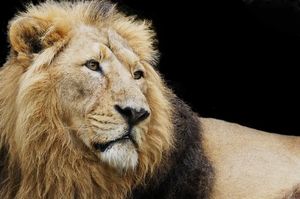The tidy pachyderm
An edited extract from Edgar Andrews’ book Who made God?,published by EP Books.
Rudyard Kipling’s ‘Just so’ stories were published in 1902, just 43 years after Darwin beat him to it withThe origin of species. If you read the stories carefully, it is difficult to avoid the impression that Kipling was (playfully) either echoing Darwin or getting back at him.
Set in an exceedingly young world, where all the animals were related and lacked many of their current features, the story of the Elephant’s Child is specially redolent of Darwin’s theory. It is, of course, the story of how the elephant got his trunk – and how greatly he was advantaged by this novel, useful and yet altogether accidental acquisition.
The trunk could be used to squash flies, pick fruit, swish water, spank trunkless animals and hoover up the melon rinds he had dropped on his way to the Limpopo river – which is why Kipling called him a ‘tidy pachyderm’.
Kipling reminds us that a theory of origins that, with a little imagination, can explain anything, actually explains nothing.
To see or not to see
I can best illustrate my point by an example. Various fish species (such as the tetra) that live in caves where light does not penetrate are blind, and this is ascribed to Darwinian evolution.
But consider now another recent discovery, reported in a London Times article: ‘A bizarre “four-eyed” fish has been found to use a unique system of mirrors to protect itself from being eaten in the dark depths of the sea’.
The creature (which rejoices in the name of the brownsnout spookfish) is ‘the only backboned creature known to use mirrors rather than lenses to get images into focus … at low light levels … the spookfish is the first vertebrate to have evolved them to help it to see’.
The fish has normal eyes but also possesses extra downward pointing ‘mirror eyes’ – which are supposed to provide a selective advantage by providing sharp images of light flashes emitted by predators in the dark ocean depths. Fascinating.
Something fishy
Whatever the Darwinian explanations offered for these various features, let me point out something, well, fishy. Evolutionary theory explains opposite effects with equal facility, maintaining that the same selective pressure (a dark environment) causes sight to be lost in one species but acquired in another.
I realise, of course, that no two environments are precisely the same. But exactly what defines whether or not a particular environmental factor is ‘selective’ in evolutionary terms?
Why would flash-torch predators be selective only for spookfish and not for every other denizen of the deep dark ocean? Why haven’t all vulnerable deep-sea fish evolved similar elaborate detection mechanisms?
And why weren’t the spookfish’s normal eyes good enough to spot something as elementary as a light flash? The questions are endless. Or perhaps not. Perhaps they lead to one big final question – is there any feature of any creature that could not be explained by one evolutionary scenario or another?
The elephant’s trunk
Let’s get back to elephants. Their elongated trunks enable them to reach food that would otherwise be inaccessible. But so does the long neck of the giraffe. Why don’t giraffes have trunks instead of long necks? And how do gazelles and wildebeests survive and prosper in the same environment as giraffes without having long necks (or trunks for that matter)?
The problem I have is that evolution can always contrive an answer to these questions and can therefore never be falsified. Yet the capacity for falsification is essential for any truly scientific theory.
So pervasive is the belief that evolution can be the only truth, that today it is simply assumed. Our friendly spookfish provides a good example. At the time of writing I greatly doubt whether any research has yet been carried out on the evolution of the brownsnout spookfish – such as attempts to trace its evolutionary ancestry and, in particular, the evolutionary pathways that led to its amazing mirror eyes.
Yet those concerned do not hesitate to state, as a matter of established fact, that the spookfish has ‘evolved [the extra eyes] to help it to see’. How can anyone be so sure that the fish has ‘evolved them’?
That’s easy. Because Darwinism dictates that evolution is the only way that any living organism can acquire any characteristic. Writing in the journal Nature, biologists Paul Ehrlich and L. C. Birch state:
‘Our theory of evolution has become … one which cannot be refuted by any possible observations. Every conceivable observation can be fitted into it. It is thus “outside of empirical science” but not necessarily false. No one can think of ways in which to test it [that is, falsify it]. Ideas, either without basis or based on a few laboratory experiments carried out in extremely simplified systems have attained currency far beyond their validity. They have become part of an evolutionary dogma accepted by most of us as part of our training’.
As far as life is concerned, evolution’s dictum is, ‘I am, therefore I evolved’. So is it a genuine science? Or might it be a materialistic philosophy-of-being balanced precariously on a narrow base of scientific fact? Let’s take a look.
Evolutionary basics
Although evolution receives blanket coverage in schools and the media, there is a surprising amount of confusion about it. So we need to review briefly the basics of the neo-Darwinian ‘synthesis’ current today. The theory attributes evolution to the interplay of two simple processes – random genetic mutations (accidental changes in the genes) and natural selection (the survival of the fittest).
Clearly, random mutations as such can have no ‘directional’ effect, such as the inexorable drive to greater complexity in living things that the theory sets out to explain. So that leaves natural selection to impose directionality and be the real driving force behind evolution.
Richard Dawkins puts it thus: ‘Chance is not a solution, given the high level of improbability we see in living organisms, and no sane biologist ever suggested that it was … of course it didn’t happen by chance … Natural selection … is the only workable alternative to chance that has ever been suggested’.
One has to wonder how Dawkins can find chance so obnoxious when it comes to the evolution of advanced organisms but so attractive as an explanation for the origin of complex genetic codes and cellular machinery. ‘Explaining’ such origins he says, ‘Suppose … life began when both DNA and its protein-based replication machinery spontaneously chanced to come into existence’ (emphasis added).
Geography matters
Nevertheless, let us imagine that, as far as evolution is concerned, natural selection is king (if not actually God) and concentrate for the moment on the natural selection of traits (as did Darwin himself, knowing nothing at that time of mutations).
So is natural selection all it is cracked up to be? Many biologists believe otherwise. One great problem with natural selection is that, in itself, it causes convergence – forcing a species into a cul-de-sac where all its protective armoury has evolved to the limit and it has nowhere else to go. Its original diversity has been eliminated by natural selection, not increased. Yet without increasing diversity no new species can arise.
Evolutionists are, of course, well aware of this problem and introduce a compensating factor – ‘geographical isolation’ (or some other form of segregation between sub-populations in a species). This allows different selective pressures to operate on the two sub-populations, leading to the formation of two groups that don’t inter-breed and can thus be called different species.
But there is a crucial down-side – geographical isolation becomes king. It usurps the throne first occupied by natural selection, because selection now needs its ‘permission’ to work any transformational magic.
Yet geographical isolation is a chance process which, almost by definition, cannot impart directionality to evolution over long periods of time – it is altogether too ad hoc to drive ever-increasing complexity over millions of years, as required by Darwinian theory.
The genetic supermarket
But there is an even bigger problem with natural selection. It can only work by reducing the genetic information (the ‘gene pool’) of a species.
Come with me to the supermarket. On arrival you are confronted with thousands of different products but you don’t want them all. So what do you do? You make a selection. Waiting at the checkout you notice idly that other people have made entirely different selections. One person may be subject to the ‘selective pressure’ of a low bank balance, so has chosen only the cheapest goods. Another’s basket might be filled with foods beloved of children, due to the selective pressure of a large family.
There is in fact an almost infinite variety of different baskets that can pass through the check-out, but none carries more than a fraction of the goods available. As far as the shopper is concerned, the remaining products are left behind and ‘lost’.
Likewise, selective pressures in nature can only produce diversification by the loss of genetic information. If natural selection causes one species to evolve into two separate species, each of the new species must lack some of the genetic content of the parent genome. Otherwise nothing new has been produced.
Natural selection, even when guided by geographical isolation, therefore, can never create new genetic information. All it can do is select different genetic baskets from the gene-pool supermarket, leaving the rest behind.
Well might Richard Dawkins admit that ‘contrary to earlier prejudices, there is nothing inherently progressive about evolution’.
Mutations to the rescue?
This being so, we are entitled to ask whence arises the inexorable progress over vast periods of time – from simple life forms to highly complex ones like you and me – that evolution claims to explain.
The answer we are offered is random genetic mutations. When it comes down to brass tacks, mutations are king and evolution goes nowhere unless new genes are being continually invented. This calls for a new chapter – in which also we shall see what the Bible has to say about the origin and development of the teeming biosphere we know today.
© 2008 Professor Edgar H. Andrews BSc, PhD, DSc, FInstP, FIMMM, CEng, CPhys
















